Bee Barn
a Pacific Northwest Coastal Beehive for
cool, damp climates.
Craig Carmichael
May 28th 2021
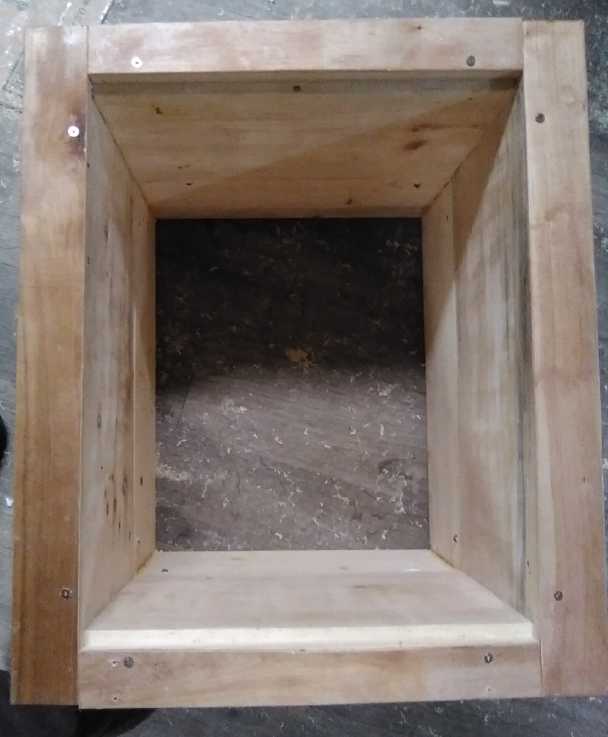 On
the Pacific Northwest coast, increasingly as one goes north, the
climate is not very conducive to keeping honey bees. The winters are
mild, but nights are cool to cold, days are often cloudy and it rains a
lot. This becomes more pronounced with latitude. By Haida Gwaii, the BC
north coast and Alaska most people living on the coast who want to keep
bees have thrown up their hands and said it's just not practical.
On
the Pacific Northwest coast, increasingly as one goes north, the
climate is not very conducive to keeping honey bees. The winters are
mild, but nights are cool to cold, days are often cloudy and it rains a
lot. This becomes more pronounced with latitude. By Haida Gwaii, the BC
north coast and Alaska most people living on the coast who want to keep
bees have thrown up their hands and said it's just not practical.
One part of what's not very practical is usually trying to keep typical
bee varieties like Italian that like dry weather and hot summers. Those
are the varieties to have over most of continental North America and so
they are most widely available. Bees such as Carniolan fare better in
cooler, damper summers, but since "cooler and damper" doesn't describe
most areas, they are harder to source.
But another big part of what's not practical is the standard Langstroth
bee hive. The uninsulated wooden boxes are implicitly intended for
areas where the bees are naturally warm all summer. In cooler oceanic
climes they can expend much of their energy just keeping the hive warm,
even in summer and most nights all year. Thus a key to having the bees
prosper is to make it easy for them to keep warm.
The key to the Bee Barn idea is the permanent large main box. It is as
tall as a Langstroth Deep plus a Medium put together. In fact, mine is
built around one of each, toe-screwed together above and below. Thus
the internal horizontal dimensions are the same as a 10 frame
Langstroth, but it has much more room. It has been described as the
"Goldilocks" size.
The box is insulated with 1 inch extruded styrene foam from a building
supply store. In my version, the outside is covered with waxed 1/4 inch
birch plywood so that the insulation isn't exposed (it would degrade),
yet without adding as much weight as thicker boards would. The
insulation of course makes it much easier keep the hive warm. The
almost cubic shape also contributes, having less surface area for the
volume.
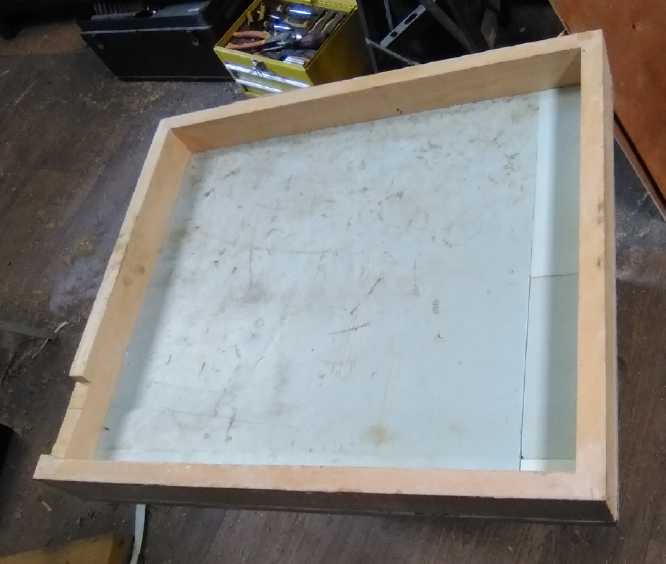 The top (above) and the floor (below, upside down)
are also insulated,
The top (above) and the floor (below, upside down)
are also insulated,
again with waxed plywood enclosing the insulation when complete.
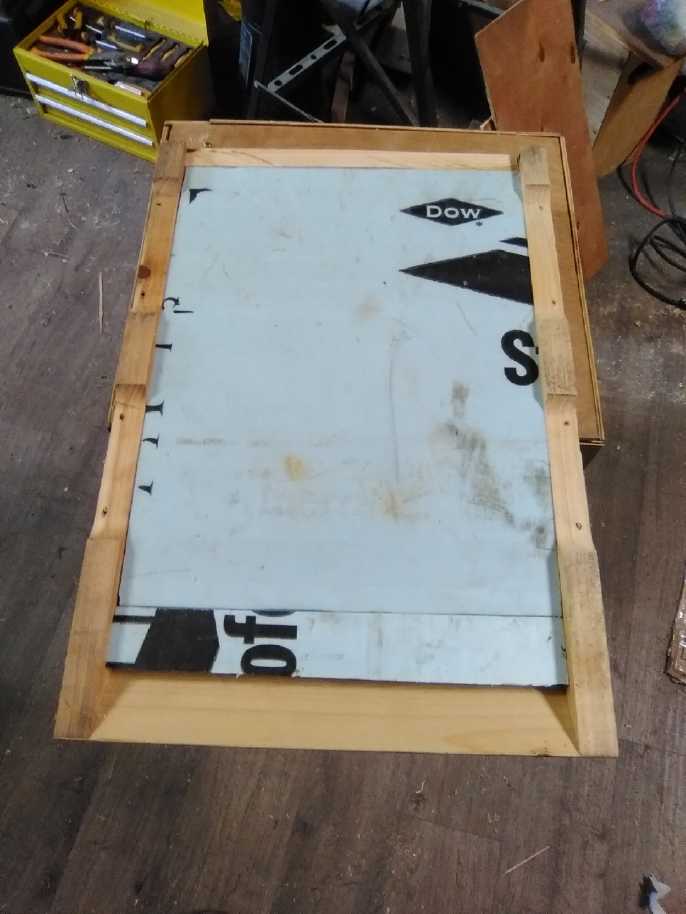
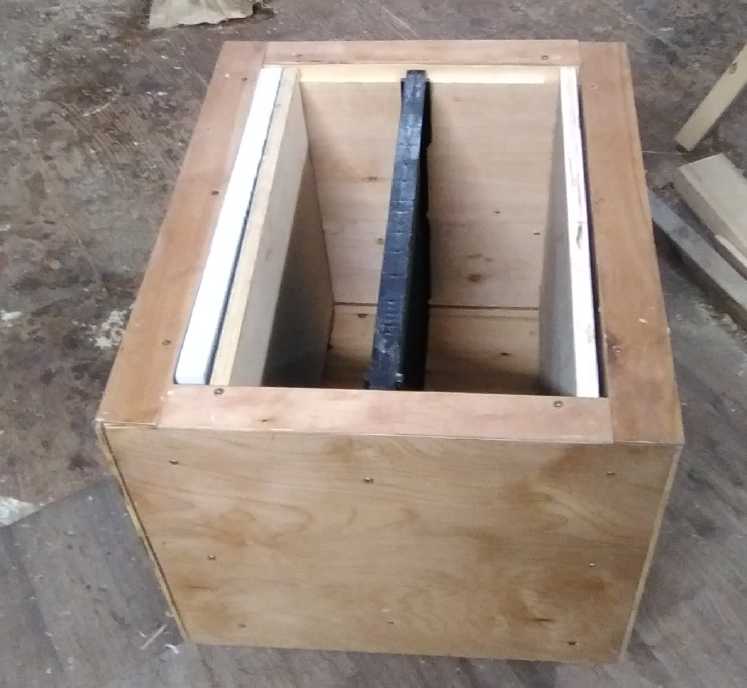 Another
contributor to heat retention is spacer boards and spacer insulation.
If a hive is going strong and full of bees, then the full bore is used.
But say a 5-frame nuc is installed: Why should the smaller number of
bees have to heat a large void space? The spacer boards can be
inserted, moved inward, and pieces of styrene insulation inserted
around the outsides to eliminate the space of the other five tall
frames. (Virtually no heat will escape to the sides with inches of
insulation there!)
Another
contributor to heat retention is spacer boards and spacer insulation.
If a hive is going strong and full of bees, then the full bore is used.
But say a 5-frame nuc is installed: Why should the smaller number of
bees have to heat a large void space? The spacer boards can be
inserted, moved inward, and pieces of styrene insulation inserted
around the outsides to eliminate the space of the other five tall
frames. (Virtually no heat will escape to the sides with inches of
insulation there!)
Speaking of nucs, five special frames are made where only the bottom
part is filled in. The top part has only a thin edge that will fit just
outside a regular frame. The frames from the nuc are slid in to the
special frames, together making a tall frame.
Spacers can be removed and empty frames added as the colony grows. At
some point a second story can be added - a super, again with insulated
walls, for honey harvesting.
Ten of the new Tall frames
make up about 17 or 18 Langstroth deep frames.
Thus 6 or 7 Tall frames is equivalent to a 10 frame 'deep super'.
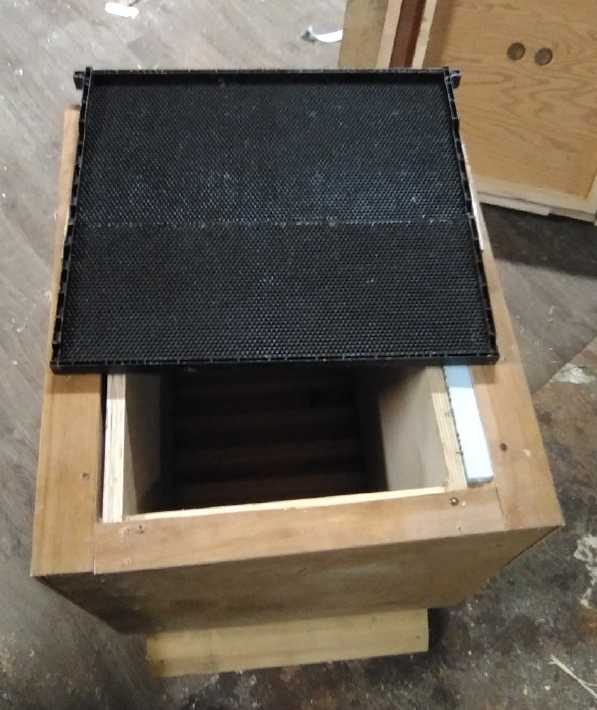 The new Tall frame (above) contrasted with regular
Langstroth deep frames,
The new Tall frame (above) contrasted with regular
Langstroth deep frames,
which would fill just over half the new box (below).
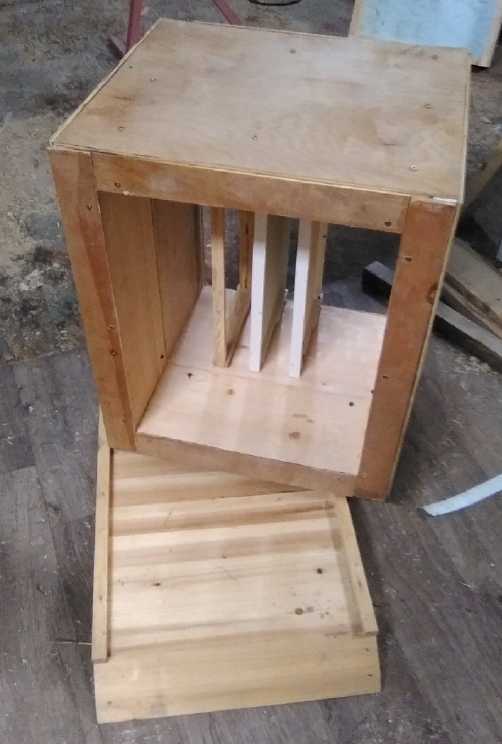
The tall frame shown is two regular black 10" frames cut and put
together using bridging pieces of white ABS plastic
across the join on the outside ends (just visible), all solved together
with methylene chloride. (Scraps of ABS and m.c. are from a plastics
shop. I use a glass eyedropper to apply the m.c. It evaporates quickly
without residue; avoid breathing/smelling it while working.) Putting
together a 10" and a 6" frame leaves a gap in between, an inch or two
that the bees can fill as they please, eg, with drone or queen cells.
Or, tall size wooden frames with horizontal wires can be made in the
usual way.
The next improvement to be added is a roof and walls over and around
the landing and hive entrance area to keep it dry even in the west
coast's frequent blowing rains. (Oh, and solid carrying handles - this
box is heavy enough even without bees! But in normal operation in a
fixed location there is no reason to move or lift it.)
The tall frames are of course heavier than shorter ones, but there are
fewer of them to lift out to inspect any given size of hive, and it's
only necessary to pull out one at a time for inspecting at any time.
And as it is the bottom box of any hive, while a honey super may have
to be removed from on top to get at it, it is never necessary to move
this big brood box to get at a box underneath. That's less lifting and
less disturbance to the bees.
This bee barn design is adapted from the original "Bee Barn" design by
Jim of "Vino Farm" youtube channel, May 2021.
Thank you Jim for freely sharing your designs and findings!


 On
the Pacific Northwest coast, increasingly as one goes north, the
climate is not very conducive to keeping honey bees. The winters are
mild, but nights are cool to cold, days are often cloudy and it rains a
lot. This becomes more pronounced with latitude. By Haida Gwaii, the BC
north coast and Alaska most people living on the coast who want to keep
bees have thrown up their hands and said it's just not practical.
On
the Pacific Northwest coast, increasingly as one goes north, the
climate is not very conducive to keeping honey bees. The winters are
mild, but nights are cool to cold, days are often cloudy and it rains a
lot. This becomes more pronounced with latitude. By Haida Gwaii, the BC
north coast and Alaska most people living on the coast who want to keep
bees have thrown up their hands and said it's just not practical.

 Another
contributor to heat retention is spacer boards and spacer insulation.
If a hive is going strong and full of bees, then the full bore is used.
But say a 5-frame nuc is installed: Why should the smaller number of
bees have to heat a large void space? The spacer boards can be
inserted, moved inward, and pieces of styrene insulation inserted
around the outsides to eliminate the space of the other five tall
frames. (Virtually no heat will escape to the sides with inches of
insulation there!)
Another
contributor to heat retention is spacer boards and spacer insulation.
If a hive is going strong and full of bees, then the full bore is used.
But say a 5-frame nuc is installed: Why should the smaller number of
bees have to heat a large void space? The spacer boards can be
inserted, moved inward, and pieces of styrene insulation inserted
around the outsides to eliminate the space of the other five tall
frames. (Virtually no heat will escape to the sides with inches of
insulation there!)
